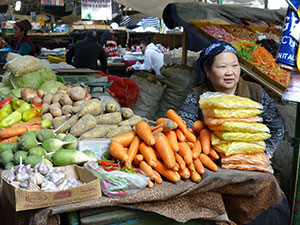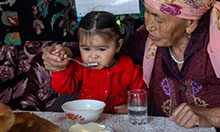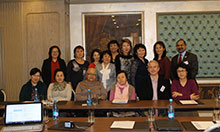
Executive Summary
To combat undernutrition in the Kyrgyz Republic, SPRING is implementing a comprehensive, multisectoral program to influence 11 nutrition-related behaviors that are linked to stunting and anemia:
- Consumption of iron supplements by pregnant women.
- Dietary diversity for women, with emphasis on food sources of iron and foods that enhance iron absorption.
- Dietary diversity for children 6 to 23 months, with emphasis on food sources of iron and vitamin A and foods that enhance iron absorption.
- Optimal meal frequency for children 6 to 23 months of age.
- Early initiation of breastfeeding.
- Exclusive breastfeeding from birth through the first six months.
- Timely introduction of appropriate complementary foods.
- Reduction in the consumption of foods of low-nutrient value (junk food).
- Presumptive treatment for helminthes for pregnant women and young children.
- Handwashing at three out of five critical times (after using the latrine, after changing a baby’s diaper/cleaning a child, before preparing food, before feeding a child, and before eating).
- Adoption of methods for safe and prolonged storage of nutrient-dense produce for the winter.
In October 2014–November 2014, SPRING carried out a baseline survey in three oblasts (regions) of the Kyrgyz Republic to gain knowledge on the current status of a range of indicators related to the above nutrition practices among women and children under two years of age. The survey was conducted by the independent research and consulting agency M-Vector in two regions where SPRING will operate (Jalalabad oblast and Jumgal district in Naryn oblast), as well as in Uzgen (Osh oblast), which was selected as a comparison region. The sample size was 900 households with at least one child under two years old—or 300 in each region selected.
The main results of the survey are reported in Table 1 (below) and expanded upon in the main body of the report. Some of the nutrition-related practices of interest were found to be already widespread in the areas surveyed, while others were underutilized; in general, improvement is possible in many areas. Among the areas most in need of improvement were hygiene, sanitation, diet diversity, and other aspects of diet and feeding. There was substantial variation in many indicators by region, with levels often substantially worse in Jumgal then in Jalalabad or Uzgen. Jumgal had lower numbers of prenatal visits, lower percentages of women consuming IFA for 90+ days, lower exclusive breastfeeding, lower diet diversity for women and children, lower prevalence of proper handwashing at critical moments, less sanitary toilet facilities, and fewer types and quantities of foods preserved.
These findings are not entirely surprising, as Jumgal is a more rural district with relatively low socioeconomic levels. It is also characterized by long winters and short growing seasons, making availability of nutrient-rich fruits and vegetables an issue, especially in winter. On the other hand, Jumgal has some advantages, such as higher ownership of livestock and greater consumption of animal-sourced foods. And while nutrition practices and conditions were better in Jalalabad than in Jumgal according to most indicators, the report nevertheless found many areas needing improvement in both regions.
SPRING has used the findings of the survey to guide planning and help focus on areas where nutrition practices are weak, to build on those that are strong, and to gather more information where findings were surprising or inconclusive. SPRING’s interventions will need to focus on all areas needing improvement and address them, bearing regional differences in mind. SPRING hopes this survey will facilitate evidence-based planning for effective project interventions, leading ultimately to improved nutrition outcomes among women and children in the Kyrgyz Republic.
Table 1. SPRING/Kyrgyz Republic core indicators for target areas in Jalalabad, Jumgal, and Uzgen
| Indicators | Baseline survey results | ||||
|---|---|---|---|---|---|
| SPRING Regions | Comparison | Total | |||
| Jalalabad | Jumgal | Uzgen | Count | % | |
| Consumption of iron supplements by pregnant women | |||||
| % of mothers of children less than 2 who took iron supplements for 90 days or more during their last pregnancy | 17% | 14% | 16% | Numerator: 142 Denominator: 900 | 16% |
| Dietary diversity for women with emphasis on food sources of iron | |||||
| % of mothers of children under two who ate foods from 5 or more of 9 food groups in the previous 24 hours | 73% | 42% | 58% | Numerator: 520 | 58% |
| % of mothers of children under two who ate iron-rich foods | 98% | 90% | 90% | Numerator: 834 | 93% |
| % of mothers of children under two who ate Vitamin C rich foods | 96% | 74% | 88% | Numerator: 772 Denominator: 900 | 86% |
| Dietary diversity for children 6 to 23 months with emphasis on food sources of iron and vitamin A, and foods or beverages that affect iron absorption | |||||
| % of children 6 – 23 months who ate foods from four or more groups in the previous 24 hours | 54% | 33% | 48% | Numerator: 272 | 45% |
| % of children 6 – 23 months who ate iron-rich foods in the previous 24 hours | 78% | 85% | 72% | Numerator: 474 | 78% |
| % of children 6 – 23 months who ate Vitamin A-source foods in the previous 24 hours | 58% | 49% | 62% | Numerator: 338 | 56% |
| % of children 6-23 months who consumed tea in the previous 24 hours | 74% | 69% | 62% | Numerator: 415 Denominator: 604 | 69% |
| Optimal meal frequency for children 6 to 23 months of age | |||||
| % of children 6-23 months who were offered food the appropriate number of times for their age and breastfeeding status | 69% | 56% | 52% | Numerator: 272 Denominator: 604 | 45% |
| Minimum acceptable diet for children 6 to 23 months of age | |||||
| % of children 6 - 23 months of age who had the minimum acceptable diet for their age and breast feeding status | 31% | 21% | 27% | Numerator: 134 Denominator: 604 | 22% |
| Early initiation of breastfeeding | |||||
| % of children who were put to the breast within one hour of birth | 67% | 79% | 54% | Numerator: 594 Denominator: 900 | 67% |
| Exclusive breastfeeding from birth through the first six months | |||||
| % of children 0-5.9 months of age who received only breast milk during the previous 24 hours | 40% | 15% | 37% | Numerator: 95 Denominator: 296 | 32% |
| Timely introduction of appropriate complementary foods | |||||
| % of children 6 – 8 months who received semi-solid or solid food during the previous 24 hours | 85% | 85% | 91% | Numerator: 115 Denominator: 131 | 88% |
| Reduction in the consumption of foods of low nutrient value (junk food) | |||||
| % of children under six months who consumed sugary food in the previous 24 hours | 12% | 20% | 6% | Numerator: 35 Denominator: 296 | 12% |
| % of children 6-23 months who consumed sugary or processed food during the previous 24 hours | 69% | 57% | 51% | Numerator: 356 Denominator: 604 | 59% |
| Average number of times per day children 6-23 months ate junk food (sugary or processed) | 1.8 | 1.7 | 1.6 | Count: 356 | 1.7 |
| Presumptive treatment for helminths for pregnant women and young children | |||||
| % of children 0-23 months who received deworming medicine | 10% | 19% | 12% | Numerator: 126 | 14% |
| % of women who received advice to take deworming medicine during pregnancy (Q12) | 12% | 7% | 5% | Numerator: 72 Denominator: 900 | 8% |

